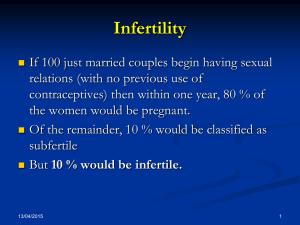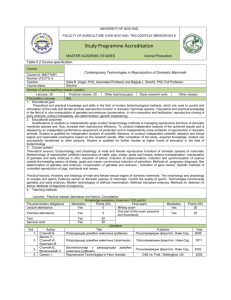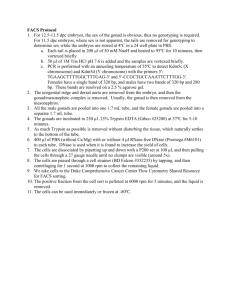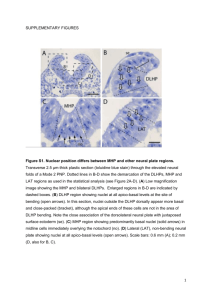Janet Minton Term Paper
advertisement
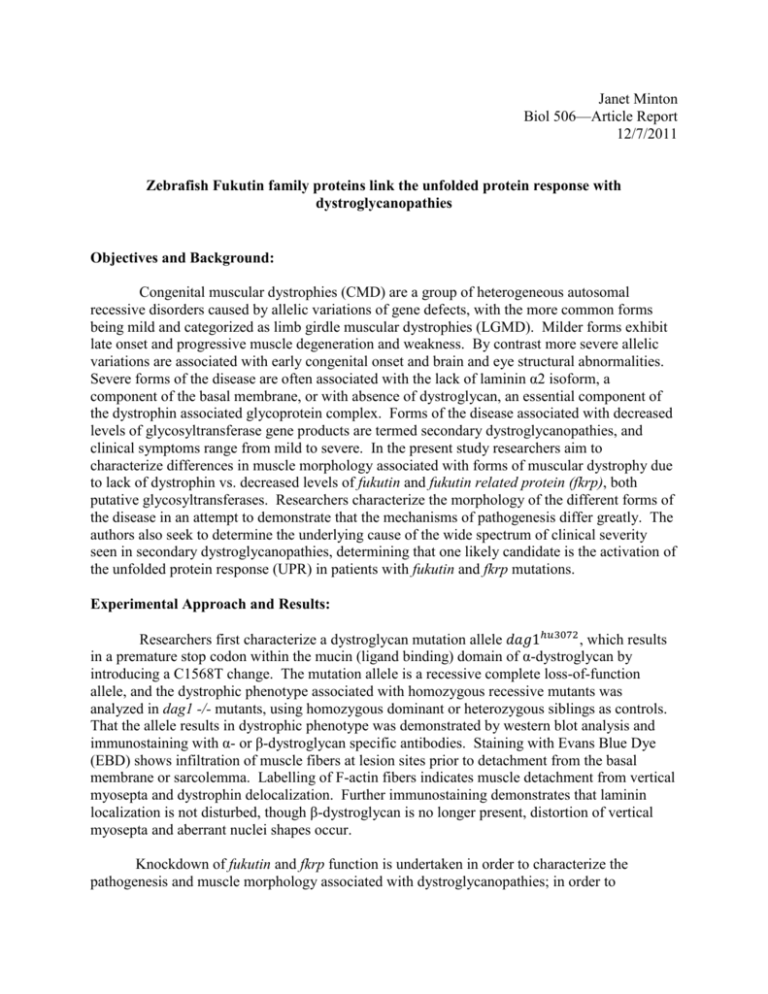
Janet Minton Biol 506—Article Report 12/7/2011 Zebrafish Fukutin family proteins link the unfolded protein response with dystroglycanopathies Objectives and Background: Congenital muscular dystrophies (CMD) are a group of heterogeneous autosomal recessive disorders caused by allelic variations of gene defects, with the more common forms being mild and categorized as limb girdle muscular dystrophies (LGMD). Milder forms exhibit late onset and progressive muscle degeneration and weakness. By contrast more severe allelic variations are associated with early congenital onset and brain and eye structural abnormalities. Severe forms of the disease are often associated with the lack of laminin α2 isoform, a component of the basal membrane, or with absence of dystroglycan, an essential component of the dystrophin associated glycoprotein complex. Forms of the disease associated with decreased levels of glycosyltransferase gene products are termed secondary dystroglycanopathies, and clinical symptoms range from mild to severe. In the present study researchers aim to characterize differences in muscle morphology associated with forms of muscular dystrophy due to lack of dystrophin vs. decreased levels of fukutin and fukutin related protein (fkrp), both putative glycosyltransferases. Researchers characterize the morphology of the different forms of the disease in an attempt to demonstrate that the mechanisms of pathogenesis differ greatly. The authors also seek to determine the underlying cause of the wide spectrum of clinical severity seen in secondary dystroglycanopathies, determining that one likely candidate is the activation of the unfolded protein response (UPR) in patients with fukutin and fkrp mutations. Experimental Approach and Results: Researchers first characterize a dystroglycan mutation allele 𝑑𝑎𝑔1ℎ𝑢3072 , which results in a premature stop codon within the mucin (ligand binding) domain of α-dystroglycan by introducing a C1568T change. The mutation allele is a recessive complete loss-of-function allele, and the dystrophic phenotype associated with homozygous recessive mutants was analyzed in dag1 -/- mutants, using homozygous dominant or heterozygous siblings as controls. That the allele results in dystrophic phenotype was demonstrated by western blot analysis and immunostaining with α- or β-dystroglycan specific antibodies. Staining with Evans Blue Dye (EBD) shows infiltration of muscle fibers at lesion sites prior to detachment from the basal membrane or sarcolemma. Labelling of F-actin fibers indicates muscle detachment from vertical myosepta and dystrophin delocalization. Further immunostaining demonstrates that laminin localization is not disturbed, though β-dystroglycan is no longer present, distortion of vertical myosepta and aberrant nuclei shapes occur. Knockdown of fukutin and fkrp function is undertaken in order to characterize the pathogenesis and muscle morphology associated with dystroglycanopathies; in order to 2 accomplish this, zebrafish embryos are injected with low-to-high doses of antisense morpholino oligonucleotides (MOs), which target translation initiation sites of the fukutin and fkrp genes. Specificity of fukutin and fkrp MO is demonstrated using RT-PCR and sequencing of aberrantly spliced transcripts. Reduction in α-dystroglycan expression was demonstrated in both fukutin and fkrp MO-injected embryos by western blot analysis and immunostaining at vertical myosepta. Development of an abnormal and complex phenotype, including the presence of Ushaped somites, twisted notochords and a shortened body axis, was shown to be correlated with high doses of MOs (or greatly reduced levels of fukutin and fkrp). Additionally, expression of fkrp enhanced green fluorescent protein was shown to be inhibited in a concentration dependent manner, and highlights the proposed roles of fukutin and fkrp in protein secretory pathways. EBD staining was again used, but in contrast to the staining of the dystrophic phenotype embryo, there was no indication of infiltration of the muscle fibers, indicating that the sarcolemma was not compromised. Labelling of F-actin demonstrated no muscle detachment. Differentiation defects of the notochord were demonstrated by testing for the molecular marker indian hedgehog homologue b (ihhb), which is not highly expressed in control or dag1 MO-injected embryos, but is expressed in fukutin and fkrp MO-injected embryos, demonstrating notochord differentiation defects. Because laminin-1 plays an important role in notochord development and the loss of the laminin-1 heterotrimer can lead to differentiation defects, fukutin and fkrp MO-injected embryos were analyzed for decreased laminin-1 immunoreactivity at the vertical myoseptum and perinotochord basement membrane (PBM), which are enriched with laminin-1 immunoreactivity in control embryos. Surprisingly, laminin-1 immunoreactivity was not reduced in fukutin MOinjected embryos although the embryos exhibit features of abnormal morphology discussed above. By contrast, fkrp MO-injected embryos show greatly reduced laminin-1 immunoreactivity. Researchers investigated the loss of laminin-1 immunoreactivity by assessing levels of expression of the three components of the laminin-1 heterotrimer (α1, β1 and γ1, encoded by lama1, lamb1 and lamc1 respectively) in fkrp MO-injected embryos. Expression levels were compared with those in control embryos, fukutin and dag1 MO-injected embryos, as well as sly/lamc1 -/- mutant embryos which show loss of the laminin-1 heterotrimer due to lack of expression of the γ1 subunit. Increases or decreases in expression were normalized to a baseline of β-actin expression. Lama1, lamb1 and lamc1 showed no significant difference in expression by comparison of the dag1 -/- embryo to the control, but were significantly upregulated in fukutin and fkrp MO-injected embryos, and significantly down-regulated in sly/lamc1 -/- embryos. The authors also analyzed the reduction of laminin α2 isoform, which has previously been associated with dystroglycanopathies and may result from mutations in fukutin or fkrp. Fukutin and fkrp MO-injected embryos were compared with the control, dag1 MOinjected embryos and sly/lamc1 -/- embryos. Lama2 downregulation was shown to be significantly higher in fukutin and fkrp MO-injected embryos than in the control, and significantly different than downregulation of lama2 observed in dag1 MO-injected and sly/lamc1 -/- embryos. Researchers demonstrated that knockdown of fukutin and fkrp may be associated with disruption of protein secretion beyond glycosylation of α-dystroglycan by immunoreactivity assays using IIH6, which reacts with a glyco-epitope that overlaps the ligand-binding site of αdystroglycan. Fukutin and dag1 MO-co-injected embryos were used to demonstrate that even in 3 the absence of dystroglycan, IIH6 epitopes accumulate in the notochord. This led researchers to conclude that the IIH6 epitope must be found on other proteins, and that abnormal secretion may be a root cause of notochord abnormalities in loss-of-fukutin phenotype. The authors further investigated the role of fukutin and fkrp in the secretory pathway using the marker BiP/GRP78, which detects activation of the UPR resulting from ER stress. Gene expression level of bip was assayed in fukutin, fkrp and dag1 MO-injected embryos, the control and sly/lamc1 -/- embryos; bip was significantly upregulated (by approximately 3 fold) in fukutin and fkrp MO-injected embryos as compared to the control, dag1 MO-injected and sly/lamc1 -/- embryos. Conclusion: There is a distinct difference in the muscle pathologies associated with a complete loss of dystroglycan as compared with embryos in which expression of fukutin and fkrp have been knocked down. While the dystrophic phenotype associated with loss of dystroglycan exhibits muscle fiber detachment, delocalization of dystrophin and disruption of the sarcolemma, muscle pathology in fukutin and fkrp MO-injected zebrafish embryos shows normal dystrophin immunoreactivity and laminin localization in combination with an unaffected basement membrane and no muscle fiber detachment. Researchers conclude this points to a mechanism other than disruption of dystroglycan-ligand interactions for the pathogenesis of dystroglycanopathies resulting from decreased expression of glycosyltransferase genes. Aberrant expression of laminin-1 heterotrimer components α1, β1 and γ1 in fukutin and fkrp MO-injected embryos, specifically the up-regulation of the genes encoding these components (lama1, lamb1 and lamc1 respectively) may lead to abnormal laminin polymerization which could result in fragility of the basement membrane and abnormal laminar structure in the brain and retina, all of have been associated with more severe forms of secondary dystroglycanopathies. Knockdown of fukutin and fkrp is associated with ER stress and activation of the UPR. The UPR subsequently deals with the accumulation of unfolded proteins by translational repression, changes in gene transcription, the ER-associated degradation (ERAD), and eventually cell-death. In this way knockdown of the glycosyltransferase genes may affect protein secretion beyond glycosylation of α-dystroglycan, and activation of the UPR could be the mechanism responsible for the wide range of clinical severity seen in dystroglycanopathies. Further Research: Confirmation of the roles of fukutin and fkrp are needed; molecular modeling and biochemical assays would be of interest to confirm the enzymatic activity of these putative glycosyltransferases. Additionally, their role in the protein secretory pathway and in activation or repression of the UPR should be further analyzed. While authors noted that BiP/GRP78 marker assays of muscle biopsies of human dystroglycanopathy patients had returned some positive results (showing UPR activation in these tissues), the results were not universal. Further study should be undertaken while controlling for variables such as clinical severity and genetic background, as well as the timing at which the biopsy is taken. 4 Citation: Lin, Y. White, R. J. Torelli, S. Cirak, S. Muntoni, F. Stemple, D. L. Zebrafish Fukutin family proteins link the unfolded protein response with dystroglycanopathies. Human Molecular Genetics, 20:9, 1763-1775.



